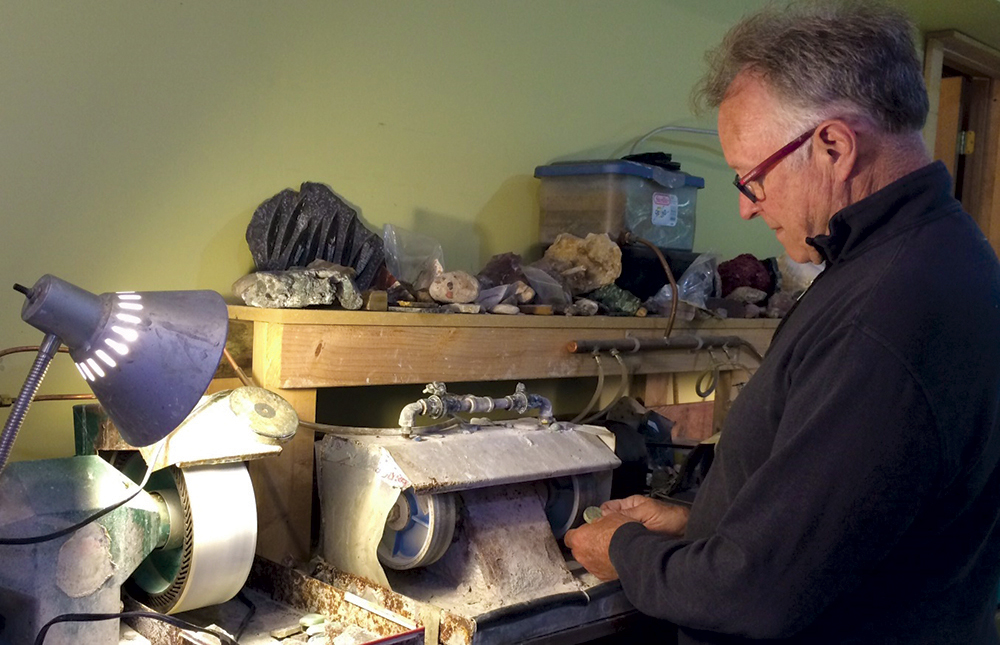Lessons from Frankfort’s former mayor
By Kelly Ottinger
Current Contributor
When asked how one builds a jewelry-making career out of a casual rock-collecting hobby, Frankfort’s former mayor, Dick Bayer, laughs and says, “Well it goes something like this: All at once you have more rocks than you know what to do with and you think, ‘I should do something with these.’ So you cut those into smaller pieces, polish some of those, and pretty soon you think, ‘I’ve got to do something with these.’ Then you make a few bracelets for your wife and daughters, and their friends start making requests. And then the thing just takes off!’”
Bayer grew up in Frankfort, and after a career of years spent in the United States Air Force (including a tour of Viet Nam), he went on to work for Michigan Bell Telephone Company, and retired from Ameritech. Shortly after, a last-minute decision found him returning to Frankfort to attend a high school reunion. There he reconnected with the former Billie Lee Gum (now Billie Lee Bayer), also originally from Frankfort but living away from the area at the time. After dating for a few years, the couple decided to marry and return to Frankfort for their retirement years, building a home and a work studio on property owned by Billie’s family.
Although Bayer knew enough about rocks to casually collect and cut his first stone while in the service, his hobby did not really take off at that point.
“I was never really a rock hound as a kid,” he says. “I didn’t start seriously collecting ’til about 15 or 16 years ago.”
At that time, he began treks along lakeshores and visits to estate sales, eventually amassing the collection that caused him to think of taking next steps. He began cutting the rocks into smaller pieces and eventually began cutting slabs from which he could cut calibrated or free-form stones for polishing. Although Bayer makes jewelry from a variety of materials, his go-to precious metal is silver.
Making jewelry for his wife and daughters allowed Bayer to develop a signature look to his work: beautifully patterned stones—both calibrated and free-form—highly polished and set in pendants, bracelets, and rings of silver.
Bayer’s artistry runs the gamut from those signature pieces to wrap bracelets, earrings, and strings of freshwater pearls and other gems. His studio is located on his private property, and although it does not keep regular retail hours, it is “open any time I’m home; just give me a call!”
Behind the curtain of his retail display is his lapidary workspace, with dozens of buckets of rocks that have been cut for the varying stages of jewelry making. There also, one finds a wealth (literally) of the machinery needed for the task at hand—everything from the diamond saw that cuts rocks into slabs to the diamond-grinding wheel, sandpaper flex wheel, and buffing wheel. The silversmith table houses the tiny torch that is used to soften and bend the precious metals, as well as several polished setting-ready stones.
Bayer says a common misconception of highly polished stones is that they are covered in a lacquer.
“Nope, that shine comes strictly from the buffing process,” he says. He uses a product called Zam for the final buffing, to obtain just the right amount of glassy sheen.
Some of the stones that are prominent in Bayer’s work include Petoskey, turquoise, Lake Superior agate, Leland Blue, Frankfort Green, Lapis Lazuli, Fordite, jelly opal, freshwater cultured pearls, tiger’s eye, labradorite, rhodocrosite, and obsidian. Bayer says his favorite stone to work with is turquoise, because it comes in such variation and cuts easily.
Speaking about the recent craze for Leland Blue and Frankfort Green, he says, “These stones are actually glass slag resulting from the iron ore smelting process. Most smelters shut down in the late 1800s, so any of these ‘stones’ found today are well over 100 years old, which helps to explain their retail value.”
Through the years, Bayer has accumulated some interesting pieces that, for one reason or another, stay in his shop in their original, uncut form.
“Some, you just look at and know you would never cut that,” he says of his larger, perfectly formed rocks and a few eclectic items, such as a meteorite and petrified dinosaur poop. “I’ve had elementary school classes visit the shop, and let me tell you, you hear some fun things about that dinosaur poop. Kids always try to smell it!”
Currently, Bayer’s favorite vehicle for sales is private home parties. The parties allow him to spend quality time with his customers, explaining each piece and how to care for it. In addition to his studio shop and private home parties, Bayer makes the art fair circuit each summer, often earning awards for his work. Most recently, he won second place at the Cadillac Art Fair, and the People’s Choice Award at the Brighton Art Fair.
To stop in and see Bayer’s shop or to arrange a home party, call his home phone at 231-352-5566. The studio/shop is located at 637 Corning Avenue, Frankfort. Or find Bayer at an art fair or festival this summer: July 9, Beulah Art Fair; July 15-16, Cadillac Art Fair; July 20, Glen Lake Women’s Club 40th Annual Art Fair at the Glen Arbor Town Hall; July 27, Congregational Summer Assembly; July 30, Crooked Tree Outdoor Art Fair at Northwestern Michigan College; August 6-7, Portside Art Fair in East Jordan; August 13, Les Cheneaux Island Antique Wooden Boat Show in the Upper Peninsula town of Hessel; and August 19-20at the Frankfort Art Fair.
Featured photo: Dick Bayer in his rock shop at his home. Photo by Kelly Ottinger.




